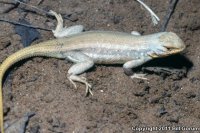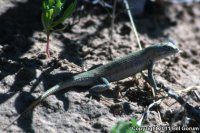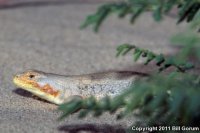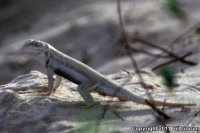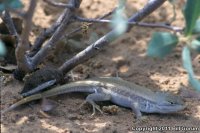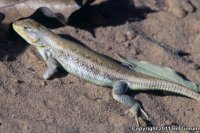| Range: |
 |
| Other Names: |
Sand Dune Lizard |
| Description: |
Sceloporus arenicolous can grow to adult total lengths of 11-15 cm (4.5-6 in). Small, granular scales on rear of thighs. Tail slightly longer than head-body length. Dorsal ground color is light gray to light brown. Dorsal pattern consists of a faint line from the head to the tip of the tail. Small dark marking in front of each foreleg. Male with blue patches on venter bordered by black; female may have pink tones on neck and sides. |
| Similar Species: |
Fence Lizards lack the granular scales on the posterior surface of the thigh, have 7 or fewer scales separating the femoral pore series and usually has paired blue throat spots (faint in females) rather than a mottled or flecked pattern. Slevin's Bunchgrass Lizard has the lateral scales arranged in rows paralell to the doral scale rows. The Sagebrush Lizard has a well-defined dorsal pattern, relatively more (48-60) scales around midbody and is known from northwestern New Mexico in Cibola, McKinley, Rio Arriba, San Juan and Sandoval counties. |
| Venom: |
None |
| Habitat: |
Sceloporus arenicolous lives among sand dunes dominated by shinnery oak (Quercus havardii). |
| Behavior: |
Active during the day, will remain motionless and seek shelter under vegetation, or will cover itself in sand when threatened. The dorsal background color of this species makes it well camouflaged among the dunes. |
| Hibernation: |
Hibernates underground during cool months. |
| Reproduction: |
Eggs are laid in early summer. |
| Diet: |
Insects |


